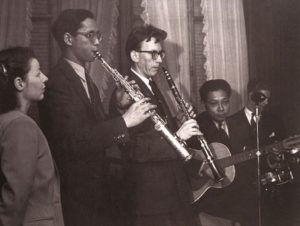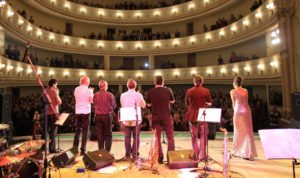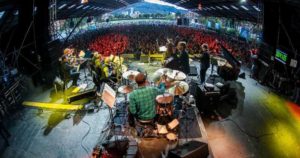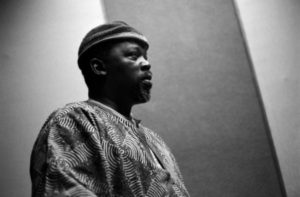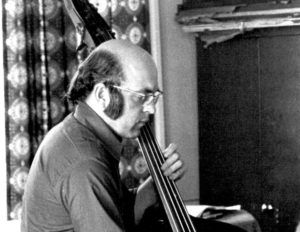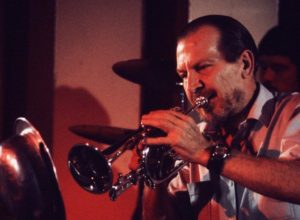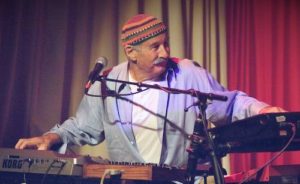Jazz in Israel
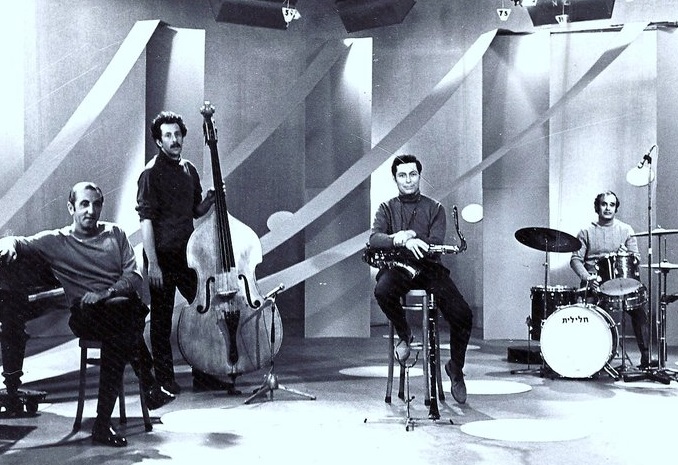
Such is the depth of jazz talent that has emerged from Israel in the last couple of decades (albeit usually via New York), that I was surprised how little information there is online about the jazz scene in the country before the 1990s. However, with a bit of digging, I’ve been able to piece together the following short history of jazz in Israel.
During the British adminstration of Mandatory Palestine (1919-1948), with tens of thousands of young national servicemen seeking entertainment, cafes and hotels would put on live music. This would usually involve European immigrant musicians, including bassist Naftali Aharoni (born 1919) from Vilna and German born pianist-composer Haim Alexander (1915-2012), who were familiar with jazz before arriving in Palestine. There were also British Army and Air Force bands, often with experienced dance band players. In Jersualem, the King David Hotel hosted jazz most nights.
After the founding of Israel in 1948, a period of chaos and the departure of British troops, put an end to the nascent jazz scene for a while. A few key moments helped reintroduce jazz in the 1950s. Renowned American vibraphonist/composer Lionel Hampton, who was a keen supporter of Israel from its foundation, composed the ‘King David Suite’ in 1953, partly in homage to his friendship with the country’s first premier, David Ben Gurion. He returned to Israel in 1955 for a tour with his orchestra. Romanian born vibraphone player Moshe Osherowitz (1925-2016) led the band 7 nights a week at the Dan Hotel in Tel Aviv, when rumours spread that Hampton and some of his musicans would be coming down. After some discussion the band decided they would impress him by playing Hampton’s ‘Flying Home’ when he arrived. As recalled by drummer Hugo Landwehr, following their set they sought his opinion of their interpretation of the tune – “You don’t swing for shit” was his alleged response. Several of Hampton’s musicians jammed with the Israeli band, and a year later on Hampton’s next visit, they had improved enough that he told the band “Now you motherfucking swing”. Louis Armstrong was the other international jazz star to visit Israel in the 1950s, and when his bass player injured himself getting off the plane, Naftali Aharoni was asked to step in.
The experience of playing with top American musicians certainly helped the development of a number of Israeli jazz musicians, and when New York-born saxophonist/clarinettist Mel Keller (1920-1998) moved to Israel in 1951, he too had a huge impact. Keller had played with trumpeter Ziggy Elman and singer Ray Eberle. After a period of playing clarinet with a classical group, Keller returned to jazz in 1956 with a group that included Aharoni. He also produced a jazz programme on the Israeli Broadcasting Service, and toured kibbutzim to demonstrate improvisation. The ZOA (Zionist Organisation of America) House, in the heart of Tel Aviv, provided a venue for jazz from the early 1960s, and Keller led the resident Israel Jazz Quartet, featuring pianist Dan Gottfried (born 1939) and drummer Aharon ‘Arale’ Kaminski (born 1939), with a repertoire that took in both swing and bebop. Both Gottfried and Kaminski would become influential figures in developing a jazz ‘economy’ in Israel. Kaminski ran Tel Aviv’s most important jazz club, Bar Barim until 1979, and together with Russian-born saxophonist/flautist Roman Kunsman (1941-2002), he also led a fusion band, The Platina, which performed at Newport Jazz Festival in 1974. Gottfried founded and ran the famous Red Sea Jazz Festival from 1987 until his retirement in 2008. He also founded the country’s first jazz studies programme in 1985 in the Thelma Yellin Arts High School in Tel Aviv.
Bulgarian born saxophonist and arranger Stu Hacohen (1929-2006) had settled in Israel in 1949, and performed with Osherowitz’s band at the Dan Hotel. In 1969, he produced what would be Israel’s first jazz recordings with his wife, singer Rimona Francis. The album ranged from fairly straightforward scat vocal versions of ‘Take Five’ and ‘Joy Spring’ to a fusion of Balkan rhythms, Israeli folk songs and jazz instrumentation. The first instrumental jazz album came in 1973, with Mezare Israel Yekabtzenu by the Jazz Workshop, a group built around Keller’s ex-pianist Dan Gottfried, and saxophonist Albert Piamenta (born 1938), who had studied with Keller. This album too demonstrates a desire to not slavishly copy American models, in its focus on Israeli folk tunes.
Other jazz artists active in Israel from the 1970s, and throughout the 1980s and 1990s, included immigrants like the South African-born artist-activist (and free jazz clarinetist) Harold Rubin (1932-2020), who based himself in Tel Aviv from 1979, recording in the 1980s with the new Israeli record label, Jazzis, founded by Adam Baruch. Another artist who recorded regularly with Jazzis was Cincinatti-born pianist Liz Magnes, who studied with Mal Waldron, and who lived and worked in Jerusalem from the early 1970s until 2000.
Since the 1990s, a consistent stream of world class jazz musicians has emerged from Israel, the majority of whom have forged their careers in New York. Among the first wave to leave their mark on the American jazz scene were guitarist Amos Hoffman, pianist Anat Fort, and bassists Omer Avital and Avishai Cohen. Cohen, in particular, is often cited as something of a ‘godfather’ to the subsequent waves of talented artists to try their luck in NYC. He began on piano, but took up electric bass after hearing Jaco Pastorius, only moving on to double bass at 20. He moved to New York in 1992 and studied at the New School alongside Brad Mehldau, while playing clubs with the likes of pianists Jason Lindner and Danilo Perez and guitarist Kurt Rosenwinkel, as well as with Hoffman. Cohen’s debut album Adama in 1998 featured a stellar band including Steve Wilson, Steve Davis and Jeff Ballard, as well as guest spots from Chick Corea, Brad Mehldau, Perez and Lindner. In 1997, he joined Corea’s group, staying with him for six years and building an impressive international recognition in that band, as well as his own International Vamp Band with Antonio Sanchez and Avi Lebovich, where Cohen sang, played piano and electric bass. Back in Israel since 2005, he has released a steady flow of impressive albums, the music evolving as he continually refreshes his bands with new young talent, often from Israel, like Shai Maestro, Nitai Hershkovits and Daniel Dor, each of whom have forged notable careers of their own.
Under the leadership of trombonist Yossi Regev since 1994, the jazz course at Thelma Yellin Arts High School has helped produce a number of significant figures in Israeli jazz, who have gone on to build careers in New York, including Cohen’s piano player Shai Maestro, bassist Omer Avital (who arrived in New York at the same time as Cohen and Hoffman), saxophonist Eli Degibri, guitarist Gilad Hekselman, and the siblings clarinettist Anat and trumpeter Avishai Cohen (not to be confused with Avishai Cohen…). Yaron Herman and Yotam Silberstein came out of similar jazz programme in another Tel Aviv High School for the Arts. Since 2002, a key factor in giving many young Israeli musicians a chance to experience and contribute to the New York jazz scene has been a partnership between the Israeli Conservatory of Music’s Center for Jazz Studies, founded by the pianist Amit Golan (1964-2010), and its partnership with the New School for Jazz and Contemporary Music. Among the New School’s Israeli alumni are guitarists Hekselmann, Rotem Sivan, and Dekel Bor, violinist Miri Ben-Ari, saxophonist Eyal Vilner, and trumpeter Itamar Borochov.
Focussing on those Israeli jazz musicians, who have made their names in New York is obviously an over-simplification. Off the top of my head, for example, I can name four musicians born in Israel – Asaf Sirkis, Gilad Atzmon, Jonathan Gee and Yaron Stavi – who have instead made significant contributions to the British jazz scene, and I’m sure the same could be said of other ex-patriate Israelis elsewhere. With musicians like the two Avishai Cohens back in Israel, the scene in the country itself has also grown. The Red Sea Jazz Festival was followed by Tel Aviv Jazz Festival in 1991, and since 2018, there is also a Jerusalem Jazz Festival.
